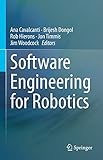Software Engineering for Robotics [electronic resource] /
Material type: TextPublisher: Cham : Springer International Publishing : Imprint: Springer, 2021Edition: 1st ed. 2021Description: XX, 483 p. 184 illus., 154 illus. in color. online resourceContent type:
TextPublisher: Cham : Springer International Publishing : Imprint: Springer, 2021Edition: 1st ed. 2021Description: XX, 483 p. 184 illus., 154 illus. in color. online resourceContent type: - text
- computer
- online resource
- 9783030664947
- 005.1 23
- QA76.758
Software Product Line Engineering for Robotics -- Towards Autonomous Robot Evolution -- Composition, Separation of Roles and Model-Driven Approaches as Enabler of a Robotics Software Ecosystem -- Testing Industrial Robotic Systems: A New Battlefield! -- Gaining Confidence in the Trustworthiness of Robotic and Autonomous Systems -- Robot Accident Investigation: A Case Study in Responsible Robotics -- Verifiable Autonomy and Responsible Robotics -- Verification of Autonomous Robots: A Roboticist's Bottom-Up Approach? -- RoboStar Technology: A Roboticist’s Toolbox for Combined Proof, Simulation, and Testing -- CorteX: A software Framework for Interoperable, Plug-and-Play, Distributed, Robotic Systems-of-Systems -- Mutation Testing for RoboChart -- Languages for Specifying Missions of Robotic Applications -- RoboStar Technology: Modelling Uncertainty in RoboChart using Probability -- Panel Discussion: Regulation and Ethics of Robotics and Autonomous Systems.
The topics covered in this book range from modeling and programming languages and environments, via approaches for design and verification, to issues of ethics and regulation. In terms of techniques, there are results on model-based engineering, product lines, mission specification, component-based development, simulation, testing, and proof. Applications range from manufacturing to service robots, to autonomous vehicles, and even robots than evolve in the real world. A final chapter summarizes issues on ethics and regulation based on discussions from a panel of experts. The origin of this book is a two-day event, entitled RoboSoft, that took place in November 2019, in London. Organized with the generous support of the Royal Academy of Engineering and the University of York, UK, RoboSoft brought together more than 100 scientists, engineers and practitioners from all over the world, representing 70 international institutions. Theintended readership includes researchers and practitioners with all levels of experience interested in working in the area of robotics, and software engineering more generally. The chapters are all self-contained, include explanations of the core concepts, and finish with a discussion of directions for further work. Chapters 'Towards Autonomous Robot Evolution', 'Composition, Separation of Roles and Model-Driven Approaches as Enabler of a Robotics Software Ecosystem' and 'Verifiable Autonomy and Responsible Robotics' are available open access under a Creative Commons Attribution 4.0 International License via link.springer.com.


There are no comments on this title.